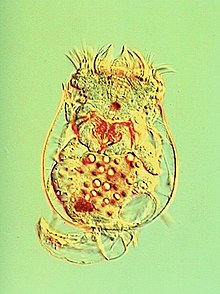Brachionus calyciflorus
| Brachionus calyciflorus | |
|---|---|

| |
| Scientific classification | |
| Kingdom: | Animalia |
| Phylum: | Rotifera |
| Class: | Monogononta |
| Order: | Ploima |
| Family: | Brachionidae |
| Genus: | Brachionus |
| Species: | B. calyciflorus
|
| Binomial name | |
| Brachionus calyciflorus Pallas, 1766
| |
Brachionus calyciflorus is a planktonic rotifer species occurring in freshwater. It is commonly used as a model organism in toxicology, ecology and evolutionary biology.
Its advantages include the small size and short generation time (average generation time of B. calyciflorus is around 2.2 days at 24 °C).
Reproduction[]
Brachionus calyciflorus normally reproduces by cyclical parthenogenesis.[1]
Transitions to obligate parthenogenesis have been described. Obligate parthenogens were homozygous for a recessive allele, which caused inability to respond to the chemical signals that normally induce sexual reproduction in this species.[2]
Species complex[]
Like the Brachionus plicatilis cryptic species complex Brachionus calyciflorus seems also to be a species complex consisting of more than one species.[3][4]
References[]
- ^ http://rotifera.lifedesks.org/pages/324[permanent dead link]
- ^ C.-P. Stelzer, J. Schmidt, A. Wiedlroither, and S. Riss (2010). Loss of Sexual Reproduction and Dwarfing in a Small Metazoan. PLoS ONE 5(9): e12854.
- ^ Brachionus calyciflorus is a species complex: mating behavior and genetic differentiation among four geographically isolated strains JJ Gilbert, EJ Walsh - Rotifera X, 2005 - Springer
- ^ Spatial patterns of genetic differentiation in Brachionus calyciflorus species complex collected from East China in summer XL Xiang, YL Xi, XL Wen, JY Zhang, Q Ma - Hydrobiologia, 2010 - Springer
- Brachionidae
- Rotifer stubs